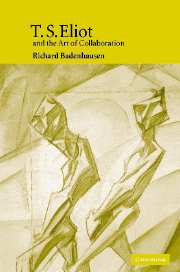Book contents
- Frontmatter
- Contents
- Acknowledgments
- List of abbreviations
- Introduction – Reaching the stillness of music
- 1 “Speaking as ourselves”: Authorship, impersonality, and the creative process in the early essays
- 2 A conversation about “the longest poem in the English langwidge”: Pound, Eliot, and The Waste Land
- 3 “Helping the poets … write for the theatre”: The transitional essays on collaboration, community, and drama
- 4 A dramatist and his midwives: Eliot's collaborations in the theatre
- 5 The Possum and the “creating critick”: Eliot's collaboration with John Hayward
- Conclusion – Placing collaboration in perspective: Voice and influence in the late essays
- Notes
- Index
1 - “Speaking as ourselves”: Authorship, impersonality, and the creative process in the early essays
Published online by Cambridge University Press: 22 September 2009
- Frontmatter
- Contents
- Acknowledgments
- List of abbreviations
- Introduction – Reaching the stillness of music
- 1 “Speaking as ourselves”: Authorship, impersonality, and the creative process in the early essays
- 2 A conversation about “the longest poem in the English langwidge”: Pound, Eliot, and The Waste Land
- 3 “Helping the poets … write for the theatre”: The transitional essays on collaboration, community, and drama
- 4 A dramatist and his midwives: Eliot's collaborations in the theatre
- 5 The Possum and the “creating critick”: Eliot's collaboration with John Hayward
- Conclusion – Placing collaboration in perspective: Voice and influence in the late essays
- Notes
- Index
Summary
“HE MUST HIDE TO REVEAL HIMSELF”: PUBLIC AND PRIVATE IDENTITY IN ELIOT
Few writers have been so alone amidst so many people. Born in 1888 to parents who were both almost forty-five years old, T. S. Eliot had early in his life the experience of living physically close to loved ones yet remaining emotionally isolated in certain ways. He once confessed to a friend that his father and mother seemed removed enough to be like “ancestors.” This helped establish a pattern in Eliot's life of reserve, withdrawal, and isolation within even the closest of relationships, whether in an intimate friendship like that with John Hayward, his roommate of a decade, or even in his first marriage to Vivien Haigh-Wood. The former learned of Eliot's second marriage only after the fact, while the latter embraced as one of the predominant themes in her published and unpublished writings the utter loneliness of a spouse trapped in an emotionally arid union. Eliot was reportedly so modest that he never shared a bedroom with his first wife and would not even consider shaving in front of her.
Yet Eliot lived an extremely public life, of the type that consisted of conducting whirlwind reading tours of America in front of thousands of eager listeners and receiving accolades that landed him on the cover of Time magazine.
- Type
- Chapter
- Information
- T. S. Eliot and the Art of Collaboration , pp. 27 - 61Publisher: Cambridge University PressPrint publication year: 2005



